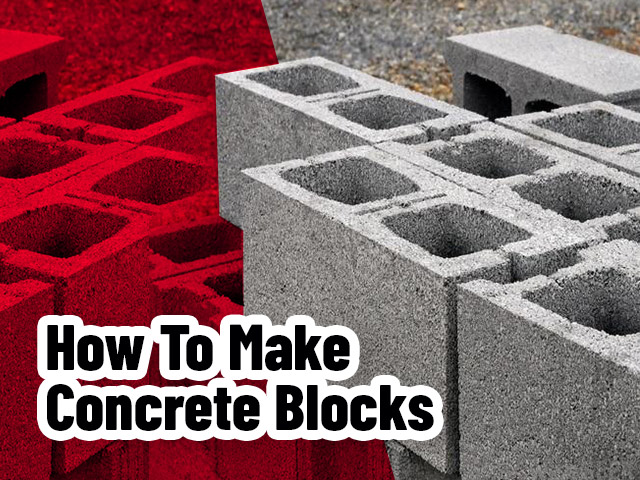
In this article, we will answer the question “How to make concrete blocks?”. Making concrete block can be done by hand if it is used for hobby purposes or for small renovations. In use for industrial purposes, blocks manufactured through block making machines should be preferred.
So, how to make concrete blocks? There are different kinds of concrete blocks. Various materials are used in the construction of all these types. And various production processes are followed. Cement is the common material used in the construction of concrete block. Water, sand and gravel are mixed into the cement. However, this concrete mixture should not be considered same as the concrete mixture used for general construction works. Because, in concrete block mixture there are use of more sand, lower gravel and water compared to other concrete mixtures.
How To Make Concrete Blocks? Which Process Is Followed?
Granulated coal or slag can be used instead of sand and gravel in concrete block making. The blocks generated right are called slag blocks. While the average weight of a typical concrete block is between 17.2 and 19.5 kg, the weight of a slag block is between 11.8 and 15.0 kg.
Another type of block is lightweight concrete blocks. In these, expansive clay is used instead of sand and gravel. The average weight of these blocks is 10.0 – 12.7 kg. These blocks are used for walls that do not carry much load. Lightweight concrete blocks can be made with pumice.
In addition to the basic materials, some chemicals can be added during concrete block making. The purpose of these chemicals is to increase the strength of the block. In addition, dye pigments can be added for coloring purposes.
The answer to the question “How to make concrete blocks?” can be explained by the following stages:
- Mixing
- Molding
- Curing
- Cubing
- Quality control
Mixing
- The materials to be used (sand, gravel and cement) are weighed to ensure that they are available in the required amount.
- Dry ingredients are transferred to a mixer and then This can be done with a bamboo mixer or a pan mixer.
- After the dry ingredients are thoroughly mixed, water is added to the mixer. If the plant is in a hot area, the temperature of the water should be adjusted carefully. At this stage, colorants and chemicals can be added. Mixing continues for about 10 minutes.
Molding
- It is poured into the conveyor after mixing.
- Concrete passes into another chamber on the block machine. The machine pushes the fluid concrete into the molds at the bottom.
- When the molds are completely filled, they are compressed with the upper mold head and hydraulic system.
- The compressed blocks are pushed out with a pallet.
Curing
- The pallets loaded with blocks are transferred to the stacker and from there to the curing rack. After each shelf is filled, it is transported to the hardening furnace.
- The hardening furnace is in the form of a chamber with a width that can fit more than one shelf at a time. Here, the blocks are baked with low pressure steam or in a high pressure steam oven called an autoclave.
Cubing
- Cured concrete blocks are removed with shelves from the oven.
- The blocks are turned into three large blocks, which are three or four blocks high and six blocks wide, and moved to the warehouse.
Quality control
In order for concrete blocks to be products that comply with the standards, they should be checked frequently during manufacturing. Meticulous care should be taken from the mixing stage to the storage stage. For example, as blocks come out of the machine, their dimensions should be checked by means of laser sensors. Or during hardening, the temperature and pressure must be adjusted correctly so that the strength of the block can be high.
